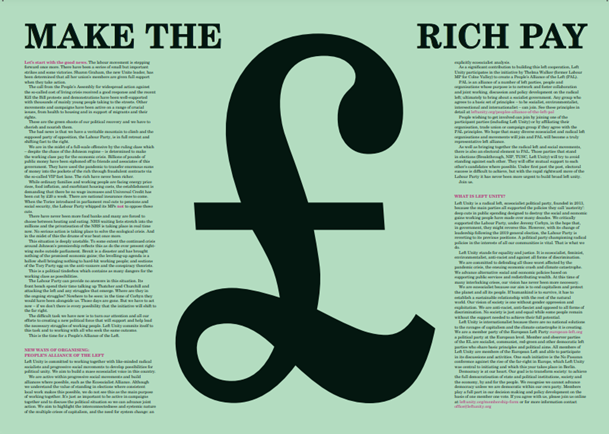La Grande Bellezza (The Great Beauty) 2013 written and directed by Paulo Sorrentino.
Reviewed by Dave Kellaway from Hackney Left Unity
Towards the end of the film the main character, Jep Gambardella, looks up at the balcony to his neighbour who is being carted off by the fraud police. The crooked businessman (all references to Berlusconi entirely intended) holds up his handcuffed hands and says look how they treat me, we are the people who actually get things done in Italy, we don’t just sit around and party like you and your bohemian friends. The short scene neatly captures both the corrupt management of Italian capital and the utter failure of the intellectual or cultural elites to provide a critique or alternative to people like Berlusconi. One stand out scene also nails the weakness and hypocrisy of a once very powerful layer of intellectuals aligned to the Italian Communist Party and its later incarnations. The party supporter criticises Jep’s effete air of superiority and inability to engage or commit to serious writing or anything else. He hesitates to respond but, after she says she can take it, he launches into one of the most devastating putdowns seen on film. So the official left is also cruelly lambasted. Certainly the deep economic recession goes hand in hand with both an ideological and political crisis which affects all classes but Sorrentino shows its effect on this upper middle class group.
Of course the film does a lot more than just capture the malaise of Italian bourgeois leadership and the vaguely bohemian sector of Rome high society that it focuses on. It is about a personal journey of failed hopes, an aborted creativity and yet a world weary acceptance of the world as it is. The main protagonist Jep Garambolo is a writer with an acclaimed first novel but who never writes a second and lives from lucrative Vogue style magazine articles. It is his 65th birthday and the film is really about his reflections on life, his milieu, pleasure and love.
Through Jep’s eyes there are lacerating and sidesplitting critiques of this milieu’s cretinism. They swallow the most superficial of modern art or performance. We have a hilarious scene where Jep’s classically trained intellect becomes more and more exasperated with the performance artist’s refusal to explain what she means by the vibrations that inspire her art. In another scene the glamorous party set stand in awe of a thirteen year old who throws paint at a screen – apparently she is paid lucratively for this art. Against this the director counterpoints the magnificent beauty of the buildings and artefacts of Rome. A friend of Jep has a special case of keys that allows him to get into particular houses owned by aristocrats which contain the most amazingly beautiful ‘secret’ artefacts or rooms. Of course this art is close off and secret from ordinary people. The film combines subtle cinematography with sublime music to create a hymn to Rome, its shapes, lines, lights and colours. Although Sorrentino’s own script is a joy of subtlety, pathos and humour it flowers within a strong visual language. Dialogue complements but does not overwhelm a real cinematic experience.
Deaths punctuate the parties, urbane conversations and aesthetic thoughts. One of Jep’s first lovers dies and her husband is distraught, a friend’s son commits suicide and one of his recent lovers dies from a chronic disease. He responds ambiguously to all of them, showing emotion but also a studied intellectual coolness. He is takes a dignified lead at the boy’s funeral but then repeats the trite phrase to the bereaved mother that he had previously rehearsed with his lover. Jep’s novel writing has become his own intervention in making and breaking parties and orchestrating witty barbs. He has embraced a sort of post-modern relativism in which nothing really matters and we have to stoically accept our own mediocrity.
Throughout the movie the presence of the Catholic Church in Rome is felt. At the beginning through visual shots and then in the final segment we are introduced to a bizarre cardinal who is supposed to be a champion exorcist but who drones on at dinner parties about how to prepare different dishes. Alongside his worldliness the ascetic, spiritual side of the Church is shown in a Mother Teresa figure called la Santa (the holy one), who has done heroic missionary work in Africa but who is visiting Rome on a personal pilgrimage. Sorrentino critically shows two sides of Italian Catholicism. He also uses the nun in a crucial exchange. La Santa, who was a fan of his first book asks Jep why he never wrote another book and he says he was not able to find the la grande bellezza (great beauty) again and he was not prepared to settle for less. She responds by saying she survives by only eating roots …because roots are important in life. Perhaps great beauty cannot be found in the aimless emptiness of his milieu.
It is not just a film about the mood or zeitgeist of Italian cultural elites today but a moving examination of personal ageing. How we all have to confront getting old, coming to terms with what we have and have not achieved for ourselves and in front of our family and friends. A scene captures this in a masterly way when Jep walks around an exhibition of one of his friends’ sons. The father had taken a picture of his son every day until he was an adolescent. The artist son had continued to take each day a photo of himself. There is no dialogue but a slow, meditative take along the baroque walls with these thousands of photos, cutting back and forth to Toni Servillo’s expressive, subtle reaction as Jep. Certainly this aspect of the film hits home harder for those of us over a certain age.
We are never quite sure whether Sorrentino supports his anti-hero’s world-weary passivity and post-modern rejection of any grand explanatory narratives or whether he is sending him up too as somebody who has the money and class position to engage in metaphysical navel gazing, who has no real roots as La Santa suggests. Surely that is the strength of the film, it holds back from creating any certainty or one dimensional reading of its story. Great cinema keeps the door open for us to find our own meaning.
[Now showing in the Picturehouse Chain, Curzon cinemas and in Arts cinemas around the country. His earlier films Il Divo on Andreotti, A Family Friend and the Consequences of Love are well worth getting out on DVD or through the on demand networks.]
5 comments
5 responses to “La Grande Bellezza (The Great Beauty) 2013 written and directed by Paulo Sorrentino.”
Left Unity is active in movements and campaigns across the left, working to create an alternative to the main political parties.
About Left Unity
Read our manifesto
Left Unity is a member of the European Left Party. 
Read the European Left Manifesto
ACTIVIST CALENDAR
Events and protests from around the movement, and local Left Unity meetings.

Saturday 29th November: National Demonstration for Palestine
END THE OCCUPATION – STOP ARMING ISRAEL – END APARTHEID
12 noon central London
More events »
GET UPDATES
Sign up to the Left Unity email newsletter.
CAMPAIGNING MATERIALS
Get the latest Left Unity resources.




Thank you for this review, Dave Kellaway. It makes me want to see this film… touching as it does on these important themes.
And me. Thanks for the review.
Best film to have come out of Italy for a decade – sums up the intellectual and political decay of Berlosconi’s Italy.
Shame someone can’t do the same for England, although reading Russell Brand’s fine description of the GQ awards in todays Guardian perhaps if he becomes a film maker …
Just seen the film and very impressed by it, so beautiful and moving.. Jep seemed to be a romantic observer, who has spent the last 30 years getting to know everyone in his world. The overtones from Fellini’s La Dolce Vita were overwhelming. A Fellini film for the era of Berlusconi and bunga-bunga parties. Made me want to know more, and see La Dolce Vita again.
Also – great to see such an interesting review on the Left Unity site.
Excellent review, the best I’ve read. You rightly focus on the importance of the ‘saint’, which most reviewers seem to miss. Just when the viewer is sure that the saint is just another comic turn, to complement the gourmet cardinal, the film unexpectedly shows her to represent the integrity absent from most of the characters). Given the saint’s point abut roots, I would disagree with your interpretation of the ‘locked away’ works of art. I don’t think there is any intention here to imply privilege – we have, after all seen the artistic and business elite in rhapsody over the spectacle of a distraught child throwing paint at the canvas. Symbolically it is the ageing stripper who is the only one with the sufficient decency to walk out in disgust and who is then taken on a tour of the locked away treasures of classical sculpture. When she askls why the guide is the person who has the keys, she is told that he can be trusted – I take that to be not a comment on privilege but on the need for integrity. This seems to symbolise an inner search for authentic culture and genuine rather than ersatz creativity. The tour does however leave the viewer with the ironic image of the hero looking dapper but slightly ridiculous, seated on front of a classical collusus – how we are, against the background of how we would have liked to see ourselves.